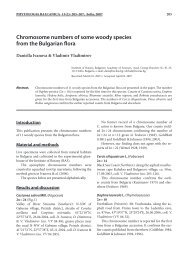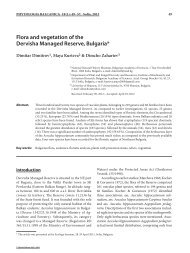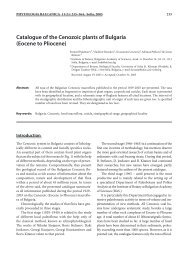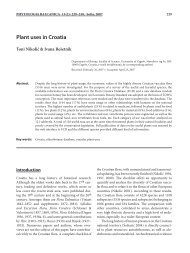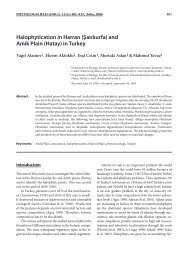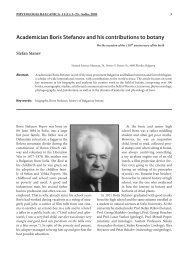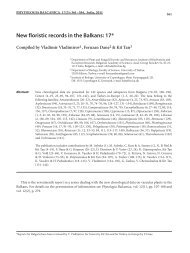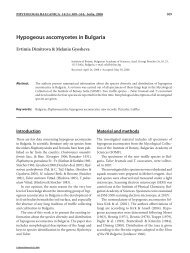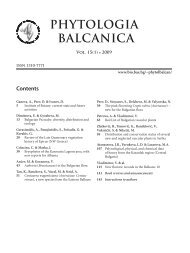Fritillaria (Liliaceae) in Serbia - Bio.bas.bg
Fritillaria (Liliaceae) in Serbia - Bio.bas.bg
Fritillaria (Liliaceae) in Serbia - Bio.bas.bg
You also want an ePaper? Increase the reach of your titles
YUMPU automatically turns print PDFs into web optimized ePapers that Google loves.
PHYTOLOGIA BALCANICA 13 (3): 359 –370, Sofia, 2007<br />
<strong>Fritillaria</strong> (<strong>Liliaceae</strong>) <strong>in</strong> <strong>Serbia</strong>: distribution, habitats and<br />
some taxonomic notes<br />
Gordana Tomović 1, Snežana Vukojičić 1, Marjan Niketić 2,<br />
Bojan Zlatković 3 & Vladimir Stevanović 1<br />
11• Phytol. Balcan. 13(3) • 2007<br />
359<br />
1 Institute of Botany and Botanical Garden, Faculty of <strong>Bio</strong>logy, University of Belgrade,<br />
43 Takovska St., 11000 Belgrade, <strong>Serbia</strong>, e-mail: gtomovic@bfbot.<strong>bg</strong>.ac.yu<br />
(author for correspondence); sneza@bfbot.<strong>bg</strong>.ac.yu; vstev@bfbot.<strong>bg</strong>.ac.yu<br />
2 Natural History Museum, 51 Njegoševa St., 11000 Belgrade, <strong>Serbia</strong>,<br />
e-mail: mniketic@nhmbeo.org.yu<br />
3 Institute of <strong>Bio</strong>logy and Ecology, Faculty of Natural Sciences, University of Niš,<br />
33 Višegradska St., 18000 Niš, <strong>Serbia</strong>, e-mail: bojanzlat@yahoo.com<br />
Received: April 04, 2007 ▷ Accepted: June 12, 2007<br />
Abstract. Notes on the distribution, taxonomy and ecology are presented for the follow<strong>in</strong>g <strong>Fritillaria</strong> species <strong>in</strong> <strong>Serbia</strong>:<br />
F. gussichiae, F. macedonica, F. meleagris subsp. meleagris, F. messanensis subsp. gracilis, and F. montana.<br />
Nomenclature and taxonomy of F. montana are particularly discussed. Furthermore, certa<strong>in</strong> ecological<br />
features (habitat, altitud<strong>in</strong>al and substrate preferences) are outl<strong>in</strong>ed for each <strong>Fritillaria</strong> taxon on the <strong>bas</strong>is of<br />
field research, herbarium and literature data.<br />
Key words: distribution, ecology, <strong>Fritillaria</strong>, <strong>Serbia</strong>, taxonomy<br />
Introduction<br />
The genus <strong>Fritillaria</strong> L. (<strong>Liliaceae</strong>) comprises bulbous<br />
perennials occurr<strong>in</strong>g <strong>in</strong> the temperate regions of the<br />
Northern Hemisphere, from Ch<strong>in</strong>a, Japan and Central<br />
Asia, through the Mediterranean region, Europe<br />
and N America. Accord<strong>in</strong>g to Rønsted & al. (2005),<br />
this genus is represented by 100 species, while Kamari<br />
& Phitos (2006) reported 145 species. The largest<br />
number of taxa has been found <strong>in</strong> Turkey (38), Ch<strong>in</strong>a<br />
(30), Greece (24), and California (18) (Rix 1998;<br />
Kamari & Phitos 2006).<br />
The East Mediterranean region is a diversity center<br />
for the genus <strong>Fritillaria</strong>, but its primary evolutionary<br />
center is probably <strong>in</strong> Iran, where taxa from different<br />
su<strong>bg</strong>enera from Central Asia, the Mediterranean<br />
region and the Caucasus meet (Rønsted & al. 2005).<br />
Thus, <strong>in</strong> N Iran, a comparatively small number of spe-<br />
cies (17, <strong>in</strong>clud<strong>in</strong>g four subspecies) represent four different<br />
su<strong>bg</strong>enera (<strong>Fritillaria</strong>, Petilium Engl., Theresia<br />
(C. Koch) Engl. and Rh<strong>in</strong>opetalum (Fisch. ex Alexander)<br />
Engl. (Rech<strong>in</strong>ger 1990)<br />
In the Balkans, the largest number of species has<br />
been found <strong>in</strong> Greece, where 24 species and five subspecies<br />
were recorded (Kamari & Phitos 2006). The<br />
authors concluded that Greece represents a secondary<br />
evolutionary centre for the su<strong>bg</strong>enus <strong>Fritillaria</strong>.<br />
In other parts of the Balkans, a comparatively small<br />
number of <strong>Fritillaria</strong> taxa were recorded. In Turkey<br />
and the East Aegean islands, 38 species were recorded,<br />
whereas only two species were reported for European<br />
Turkey (Başak 1991).<br />
The follow<strong>in</strong>g numbers of taxa at the rank of species<br />
and subspecies have been recorded <strong>in</strong> the Balkan<br />
countries:<br />
Bulgaria: six native species (Yanev 1964);
360 Tomović, D. & al. • <strong>Fritillaria</strong> <strong>in</strong> <strong>Serbia</strong><br />
Republic of Macedonia: six native species (Bornmüller<br />
1928; Micevski 1978; Matevski pers. comm.);<br />
Albania: five species with six subspecies (Vangjeli<br />
2000);<br />
<strong>Serbia</strong>: five taxa (Diklić 1975; Amidžić & al. 1998);<br />
Montenegro: three species, of which two taxa are doubtful<br />
(Rohlena 1942; Pulević 2005);<br />
Bosnia and Herzegov<strong>in</strong>a: three species (Beck 1903);<br />
Croatia: three species with four subspecies (Nikolić<br />
2006);<br />
Slovenia: two native species (Mart<strong>in</strong>čič & al. 1999);<br />
Romania: two native species (Zahariadi 1966; Cor neanu<br />
& Popescu 1981).<br />
On the Balkan Pen<strong>in</strong>sula, the number of <strong>Fritillaria</strong><br />
taxa evidently <strong>in</strong>creases from the north to the southeast.<br />
The aim of this study is to present the currently<br />
known distribution of five taxa of the genus <strong>Fritillaria</strong> <strong>in</strong><br />
<strong>Serbia</strong> and also to elucidate certa<strong>in</strong> morphological, taxonomical<br />
and nomenclature problems of the genus <strong>in</strong> this<br />
part of the Balkans. Also, ecological features of each <strong>Fritillaria</strong><br />
species <strong>in</strong> <strong>Serbia</strong>, <strong>in</strong>clud<strong>in</strong>g substrate preferences,<br />
altitud<strong>in</strong>al range and habitat types are presented.<br />
Material and methods<br />
The present study of the genus <strong>Fritillaria</strong> <strong>in</strong> <strong>Serbia</strong> is<br />
<strong>bas</strong>ed on field observations and plant material collected<br />
<strong>in</strong> most of the regions of <strong>Serbia</strong> proper and Vojvod<strong>in</strong>a.<br />
All relevant literature was also checked for additional<br />
<strong>in</strong>formation on the distribution patterns of<br />
five <strong>Fritillaria</strong> species. Dried material was determ<strong>in</strong>ed<br />
and/or revised from the collections of the Belgrade<br />
University Herbarium (BEOU) and the Herbarium of<br />
the Natural History Museum, Belgrade (BEO). Species<br />
distribution <strong>in</strong> <strong>Serbia</strong> is presented on UTM maps<br />
(10×10 km 2 grid).<br />
Results and discussion<br />
Accord<strong>in</strong>g to recent literature data, five native taxa of<br />
the genus <strong>Fritillaria</strong> were recorded <strong>in</strong> <strong>Serbia</strong>: F. gussichiae,<br />
F. macedonica., F. meleagris subsp. meleagris,<br />
F. messanensis subsp. gracilis, and F. montana (Diklić<br />
1975; Amidžić & al. 1998). All species belong to su<strong>bg</strong>enus<br />
<strong>Fritillaria</strong>, section <strong>Fritillaria</strong>, and are divided <strong>in</strong>-<br />
to two series: ser. Alternifoliae A. Los. (F. montana, F.<br />
macedonica, F. meleagris) and ser. Trichostylae Boiss.<br />
(F. messanensis, F. gussichiae). The species from su<strong>bg</strong>enus<br />
<strong>Fritillaria</strong> have a chromosome number 2n = 24,<br />
except for F. montana and F. ruthenica Wikström, which<br />
have 2n = 18 (Kamari & Phitos 2006).<br />
1. <strong>Fritillaria</strong> gussichiae (Degen & Dörfl.) Rix (Fig. 6a)<br />
Syn. F. graeca auct. non Boiss. & Spruner; F. graeca<br />
Boiss. & Spruner var. gussichiae Degen & Dörfl.<br />
General distribution. It is a Balkan endemic, distributed<br />
<strong>in</strong> N Greece, Albania, Republic of Macedonia, S<br />
<strong>Serbia</strong>, and SW Bulgaria. It is <strong>in</strong>cluded <strong>in</strong> Red Data<br />
Book of the PR Bulgaria (Velchev 1984 sub. F. graeca)<br />
<strong>in</strong> the Rare (R) species category. Formerly, it was considered<br />
a variety of F. graeca, but accord<strong>in</strong>g to Kamari<br />
(1991b), it is closer to F. pontica Wahlenb., from which<br />
it differs <strong>in</strong> the narrower w<strong>in</strong>gs of the capsules and <strong>in</strong><br />
the amplexicaul lower leaves. The shape and colour of<br />
the flowers is dist<strong>in</strong>ctive (see Fig. 6a) and F. gussichiae<br />
appears to be a well-def<strong>in</strong>ed species.<br />
Floristic element. Mediterranean-Sub me di tte ran ean<br />
/E Submediterranean/ Balkan (N-C Scardo-P<strong>in</strong>dhian-SW<br />
Moesian)<br />
Distribution <strong>in</strong> <strong>Serbia</strong>. The species was mostly cited<br />
under the name F. graeca, or F. graeca var. gussichiae<br />
for the region of S <strong>Serbia</strong>. It was recorded <strong>in</strong> Mt Kozjak:<br />
Prohor Pč<strong>in</strong>jski Monastery, EM-78 (Ranđelović &<br />
Stamenković 1985; Nikolić & al. 1986), Mt Krstilovica,<br />
EN-71 (Fritsch 1909; Diklić 1975), Mt Pljačkovica,<br />
EN-71 (Diklić 1975), Preobraženje village near Vranje,<br />
EN-82 (Fritsch 1909; Ničić 1893, 1894), Sob<strong>in</strong>a village<br />
near Vranje, EN-71 (Ničić 1894), and Mt Rujan,<br />
EM-67, EM-68, EM 69 (Ranđelović & Stamenković<br />
1984, 1985, 1986; Nikolić & al. 1986).<br />
Note: records for Metohija region – Mt Koprivnik near<br />
Peć, DN-31, DN-32 (Grebenščikov 1943; Diklić 1975;<br />
Amidžić & Panjković 2003) and Mt Šara – Jaž<strong>in</strong>acko<br />
Lake cirque, DM-96 (Amidžić & Belij 1996; Petkovski<br />
& al. 1996) are most probably <strong>in</strong>correct and refer to<br />
another species. There are no herbarium specimens,<br />
either <strong>in</strong> BEO or <strong>in</strong> BEOU to confirm these citations.<br />
A record from Prokletije Mts probably refers to F. messanensis<br />
subsp. gracilis, whereas one from Mts Šara<br />
may represent F. macedonica.<br />
New floristic records <strong>in</strong> <strong>Serbia</strong>. S <strong>Serbia</strong>: Preševo:<br />
Miratovac village, EM-57, ass. Orno-Quercetum pubescentis,<br />
serpent<strong>in</strong>ite, 500 m, leg. B. Zlatković, V.
Phytol. Balcan. 13(3) • Sofia • 2007<br />
Fig. 6. <strong>Fritillaria</strong> species with fl owers:<br />
a – F. gussichiae (S <strong>Serbia</strong>, <strong>in</strong> the vic<strong>in</strong>ity of Prohor Pč<strong>in</strong>jski Monastery, photo B. Zlatković);<br />
b – F. meleagris (C <strong>Serbia</strong>, Kraljevo: <strong>in</strong> the surround<strong>in</strong>gs of Grdica village, photo S. Vukoijičić);<br />
c – F. messanensis (Montenegro, Boka Kotorska bay, Luštica pen<strong>in</strong>sula, photo D. Lakušić);<br />
d – F. montana (W <strong>Serbia</strong>, <strong>in</strong> the surround<strong>in</strong>gs of Gornji Milanovac, Brđanska gorge, serpent<strong>in</strong>ite, photo S. Vukojičić);<br />
e – “F. degeniana” (Banta, Deliblatska Sands, photo S Vukojičić);<br />
f – “F. degeniana”- NE <strong>Serbia</strong>, between Ram and Zatonje, near the Danube River, photo S. Vukojičić).<br />
Ranđelović & D. Jović, 08.05.2003, (BEO 16153); Bujanovac:<br />
<strong>in</strong> the surround<strong>in</strong>gs of Lučane village, EN-50,<br />
EM-59, leg. V. Nikolić, 03.01.1967, det. N. Diklić, sub.<br />
F. graeca var. gussichiae (BEO 39667); Vladič<strong>in</strong> Han:<br />
Bal<strong>in</strong>ovce village, EN-83, leg. Anonymous, sub. F. graeca<br />
var. gussichiae (BEOU) (Fig. 1).<br />
Habitat and ecology. The species grows <strong>in</strong> various<br />
types of thermophilous habitats. In Bulgaria, it <strong>in</strong>hab-<br />
361<br />
its xerophilous pastures and rocky grounds, as well as<br />
forests and scrub formations at altitudes from 300 m to<br />
1320 m; only <strong>in</strong> the Rila Mts it reaches 1800 m (Yanev<br />
1964). In S <strong>Serbia</strong>, it is recorded <strong>in</strong> thermophilous<br />
oak forests (ass. Quercetum fra<strong>in</strong>etto-cerris, ass. Orno-<br />
Quercetum pubescentis, ass. Quercetum montanum su<strong>bas</strong>s.<br />
carp<strong>in</strong>etosum orientalis) and scrub communities<br />
on siliceous, serpent<strong>in</strong>ite, granite, and limestone bed-
362 Tomović, D. & al. • <strong>Fritillaria</strong> <strong>in</strong> <strong>Serbia</strong><br />
Fig. 1. Distribution of the species F. gussichiae <strong>in</strong> <strong>Serbia</strong>. Indication<br />
of localities: grey circle-white center – new chorological<br />
data; grey circle-black center – literature data; grey circle – both<br />
literature and herbarium data; ? – doubtful; – erroneous.<br />
rocks, at altitudes between 450 m and 800 m. On Mt<br />
Rujan, it grows <strong>in</strong> a steppe-like formation of ass. Festuco-Chrysopogonetum<br />
grylli form<strong>in</strong>g particular su<strong>bas</strong>s.<br />
fritillarietosum (Ranđelović & Stamenković 1984).<br />
2. F. macedonica Bornm.<br />
General distribution. This Scardo-P<strong>in</strong>dhian local endemic<br />
plant was described from Mt Jablanica (locus<br />
classicus) <strong>in</strong> SW Macedonia (Bornmüller 1923). It is also<br />
distributed <strong>in</strong> E & C Albania: Gurabardhe, Jablanice,<br />
Mal me Gropa, Golloborde, Klenje and Mali i Zebes<br />
(Vangjeli & al. 1994), and <strong>in</strong> SW <strong>Serbia</strong> <strong>in</strong> the Metohija<br />
region (Amidžić & al. 1998). In Albania, it is <strong>in</strong>cluded<br />
<strong>in</strong> the Red Book of Threatened and Rare Plants Species<br />
(Vangjeli & al. 1994) <strong>in</strong> the Rare (R) species category.<br />
Furthermore, the species is <strong>in</strong>cluded <strong>in</strong> the Red Data<br />
Book of the Flora of <strong>Serbia</strong> (Amidžić & Krivošej 1999)<br />
<strong>in</strong> the Critically Endangered (CR) category.<br />
This taxon belongs to the aggregate of F. montana<br />
and its closest relative may be F. epirotica Tur-<br />
?<br />
rill ex Rix, a high-altitude serpent<strong>in</strong>e endemic from<br />
NW Greece. Floristic element: Central-South European<br />
mounta<strong>in</strong>s/South European mounta<strong>in</strong>s/Balkan<br />
mounta<strong>in</strong>s (N Scardo-P<strong>in</strong>dhian mounta<strong>in</strong>).<br />
Distribution <strong>in</strong> <strong>Serbia</strong>. This high-mounta<strong>in</strong> species<br />
was recently found <strong>in</strong> Mt Šara – Bistrica Peak and<br />
Jaž<strong>in</strong>ce cirque – DM-96 (Amidžić & Krivošej 1998;<br />
Amidžić & al. 1998), the locality represent<strong>in</strong>g the<br />
northernmost limit of the distribution of the species.<br />
New floristic record <strong>in</strong> <strong>Serbia</strong>. Metohija: Mts Šara:<br />
G<strong>in</strong>e Vode – Mekuš Bor – Careve Livade – DM-96,<br />
EM-06, ass. Juniperus nana-Bruckenthalia spiculifolia,<br />
silicate, 1900 m, (leg. Stevanović, V. 7441, 24.06.1997<br />
(BEOU) (Fig. 2).<br />
Habitat and ecology. In the Republic of Macedonia (Mt<br />
Jablanica – locus classicus) this species <strong>in</strong>habits highmounta<strong>in</strong><br />
pastures and rocky places, at altitudes from<br />
1600 m to 1800 m. Accord<strong>in</strong>g to Amidžić and Krivošej<br />
(1999), it grows on flat or gently slop<strong>in</strong>g terra<strong>in</strong>s, on<br />
humid-rich siliceous soils on granite and granodiorite<br />
bedrocks, with<strong>in</strong> a brushwood association of Juniperus<br />
nana-Bruckenthalia spiculifolia. It can be found at altitudes<br />
between 1900 m and 2250 m.<br />
Fig. 2. Distribution of the species F. macedonica <strong>in</strong> <strong>Serbia</strong> (<strong>in</strong>dication<br />
of localities as <strong>in</strong> Fig. 1).
Phytol. Balcan. 13(3) • Sofia • 2007<br />
3. F. meleagris L. subsp. meleagris (Fig. 6b)<br />
General distribution. This species has a wide distribution<br />
range, encompass<strong>in</strong>g Great Brita<strong>in</strong>, France, Netherlands,<br />
Germany, Switzerland, Austria, Hungary, Slovakia,<br />
Czech Republic, Poland, Italy, Slovenia, Croatia, Bosnia<br />
and Herzegov<strong>in</strong>a, Montenegro (questionable), <strong>Serbia</strong>,<br />
Romania, and the Russian Federation (Western & Central<br />
parts). It is <strong>in</strong>troduced <strong>in</strong> Denmark, F<strong>in</strong>land, Norway,<br />
Sweden, and <strong>in</strong> the Baltic region. In Europe, F. meleagris<br />
is divided <strong>in</strong>to subsp. meleagris and subsp. burnatii<br />
(Planchon) Rix; the latter is distributed <strong>in</strong> the S & SW<br />
Alps (Rix 1980). Floristic element: Central European.<br />
Note: In Bulgaria, the vicarious species F. meleagroides<br />
Patr<strong>in</strong> ex Schult. f. was reported to <strong>in</strong>habit wet meadows<br />
<strong>in</strong> the western parts of the country (surround<strong>in</strong>gs of Sofia<br />
region, Dragomansko Marsh, Bozhourishte and Novi<br />
Han villages). All localities are close to the <strong>Serbia</strong>n-Bulgarian<br />
border. S<strong>in</strong>ce it is very rare, threatened and already<br />
ext<strong>in</strong>ct <strong>in</strong> some localities (<strong>in</strong> the vic<strong>in</strong>ity of Bozhourishte),<br />
it is <strong>in</strong>cluded <strong>in</strong> the Red Data Book of the PR Bulgaria<br />
(Velchev 1984) <strong>in</strong> the Endangered (E) species category.<br />
This species is also distributed <strong>in</strong> the Russian<br />
Federation (European part and W Siberia), and Central<br />
Asia. Bear<strong>in</strong>g <strong>in</strong> m<strong>in</strong>d that similar habitats (wet meadows<br />
on carstic muds) also exist <strong>in</strong> E <strong>Serbia</strong> (<strong>in</strong> the surround<strong>in</strong>gs<br />
of Odorovce and Smilovci villages near Pirot,<br />
and Krupac village near Dimitrovgrad), it seems very<br />
likely that F. melagrioides might be also found there.<br />
Distribution <strong>in</strong> <strong>Serbia</strong>. Distribution of this species <strong>in</strong><br />
<strong>Serbia</strong> is well known. It was found <strong>in</strong> NW <strong>Serbia</strong>: <strong>in</strong><br />
the surround<strong>in</strong>gs of Šabac, CQ-95 (Pančić 1874; Bobić<br />
1900), the surround<strong>in</strong>gs of Valjevo, DQ-10 (L<strong>in</strong>dtner<br />
1960); and Pomoravlje region – near Ljubičevo EQ-13<br />
(Pančić 1874) and Babuš<strong>in</strong>ac villages, EQ-14 (L<strong>in</strong>dtner<br />
1960). It was also recorded <strong>in</strong> Šumadija region: <strong>in</strong> the<br />
surround<strong>in</strong>gs of Smederevska Palanka, DQ-80, DQ-90,<br />
DQ-91 (Jovanović & Dunjić 1951; L<strong>in</strong>dtner 1960), the<br />
surround<strong>in</strong>gs of Obrenovac, DQ-33, DQ4, DQ-44 (Gajić<br />
1965; L<strong>in</strong>dtner 1960) and the surround<strong>in</strong>gs of Lazarevac<br />
DQ-41, DQ-42 (L<strong>in</strong>dtner 1960); and <strong>in</strong> Banat region –<br />
Deliblatska Sands (without exact citation of locality): <strong>in</strong><br />
wet places – FQ-06 (Stojanović 1983). However, some favorable<br />
habitats of the species (hygromesophilous forests<br />
and meadows) <strong>in</strong> the border<strong>in</strong>g area of Deliblatska Sands,<br />
fac<strong>in</strong>g the Danube and Karas rivers, have to be checked<br />
out <strong>in</strong> the field. If the latter citation is confirmed, the locality<br />
<strong>in</strong> Deliblatska Sands would represent the northernmost<br />
record of the species range <strong>in</strong> <strong>Serbia</strong>.<br />
363<br />
New floristic records <strong>in</strong> <strong>Serbia</strong>. Šumadija: Lazarevac,<br />
Kolubara river valley, DQ 31, <strong>in</strong> a hygrophilous oak<br />
forest (leg. Sigunov, A. 39668, 08.04.1973, det. Diklić,<br />
N.(BEO); Mladenovac: <strong>in</strong> the surround<strong>in</strong>gs of Markovac<br />
(Međulužje village), DQ-71 (leg. Anonymous<br />
11040, (BEOU); C <strong>Serbia</strong>: Kraljevo: <strong>in</strong> the surround<strong>in</strong>gs<br />
of Grdica village, DP-74, <strong>in</strong> a hygrophilous shadow<br />
forest near a stream, 190 m (leg. Ljaljević-Grbić,<br />
M., 25.03.2000, det. Vukojičić, S., (BEOU) (Fig. 3).<br />
Habitat and ecology. In the former countries of Yugoslavia<br />
(Slovenia, Croatia, and Bosnia and Herzegov<strong>in</strong>a) this<br />
plant <strong>in</strong>habits alluvial lowlands, wet submontane oak forests<br />
and wet meadows (Mart<strong>in</strong>čič & al. 1999; Schlosser &<br />
Vukot<strong>in</strong>ović 1876; Beck 1903). In <strong>Serbia</strong>, the plant grows<br />
<strong>in</strong> hygromesophilous meadows and <strong>in</strong> lowland oak forests<br />
(remnants of Quercus robur and Frax<strong>in</strong>us angustifolia<br />
forests) belong<strong>in</strong>g to ass. Querceto-Frax<strong>in</strong>etum serbicum<br />
mixtum and Querco-Carp<strong>in</strong>etum (Q. robur and Carp<strong>in</strong>us<br />
betulus forests), at altitudes between 100–250 m. A comparison<br />
of the current status of F. meleagris populations<br />
and their state <strong>in</strong> <strong>Serbia</strong> with their status 50 years ago<br />
shows that the populations have decreased to an extent at<br />
which they might be considered endangered.<br />
Fig. 3. Distribution of the species F. meleagris subsp. meleagris <strong>in</strong><br />
<strong>Serbia</strong> (<strong>in</strong>dication of localities as <strong>in</strong> Fig. 1).<br />
?
364 Tomović, D. & al. • <strong>Fritillaria</strong> <strong>in</strong> <strong>Serbia</strong><br />
4. F. messanensis Raf<strong>in</strong>. subsp. gracilis (Ebel) Rix<br />
(Fig. 6c)<br />
Syn. F. gracilis (Ebel) Asch. & Graebn.; F. neglecta Parl.;<br />
Lilium gracile Ebel<br />
General distribution. F. messanensis was described from<br />
Italy (Sicily, Mess<strong>in</strong>a – locus classicus). Its distribution comprises<br />
Italy (Sicily and Calabria) and the Balkan Pen<strong>in</strong>sula.<br />
The species is divided <strong>in</strong>to subsp. messanensis and subsp.<br />
gracilis (Ebel) Rix; the latter was orig<strong>in</strong>ally described as F.<br />
gracilis from Montenegro (Mt Sutorman – locus classicus).<br />
Floristic element: Mediteranan-Submediteranean/C. Submediterranaean/Illyrian<br />
Submediterranean.<br />
In the Balkans, F. messanensis s.l. was recorded along<br />
the north and central parts of the Dalmatian coast <strong>in</strong><br />
Croatia (Nikolić 2006), Bosnia and Herzegov<strong>in</strong>a (Beck<br />
1903), and Montenegro (Rohlena 1942). In the cont<strong>in</strong>ental<br />
parts of the Balkans, it was found <strong>in</strong> SW <strong>Serbia</strong><br />
(Diklić 1975), Montenegro and N Albania (Baldaccii<br />
1901, sub. F. neglecta; Hayek 1917, 1924; Jávorka 1926;<br />
Vangjeli 2000). There is an <strong>in</strong>trigu<strong>in</strong>g record from the<br />
southern part of R Macedonia (Mt Bigla, near Gopeš)<br />
published by Bornmüller (1928), who reported it as new<br />
to Macedonia under the name F. neglecta. The record<br />
needs to be checked out <strong>in</strong> the field.<br />
There is certa<strong>in</strong> confusion concern<strong>in</strong>g the presence<br />
of F. messanensis s.l. <strong>in</strong> Croatia. In the Flora Croatica<br />
Data<strong>bas</strong>e (Nikolić 2006), both subspecies are listed for<br />
this territory and their distribution maps are presented.<br />
Furthermore, F. messanensis subsp. gracilis is <strong>in</strong>cluded<br />
<strong>in</strong> the Red Book of Vascular Flora of Croatia (Mihelj<br />
2005). Despite these facts, Kamari & Phitos (2006) considered<br />
that the specimens from Croatia do not belong<br />
to this species, without <strong>in</strong>dicat<strong>in</strong>g what taxon it might<br />
be. In the Flora Albania (Vangjeli 2000) both subspecies<br />
are listed aga<strong>in</strong>, and F. messanensis subsp. gracilis is also<br />
<strong>in</strong>cluded <strong>in</strong> the Red Book of Threatened and Rare Plants<br />
Species (Vangjeli & al. 1994) <strong>in</strong> the Endangered (E) species<br />
category. Still, Kamari & Phitos (2006) ma<strong>in</strong>ta<strong>in</strong><br />
that only subsp. gracilis is distributed <strong>in</strong> Albania. Obviously,<br />
much is still uncerta<strong>in</strong> about the distribution of<br />
the two subspecies on the Balkan Pen<strong>in</strong>sula, and all literature<br />
records need to be checked <strong>in</strong> the field.<br />
After review<strong>in</strong>g a large number of floristic papers<br />
(Diklić 1975; Rix 1980; Mihelj 2005; Kamari & Phitos<br />
2006), we have noticed that differential characters<br />
presented <strong>in</strong> many keys for differentiation of these two<br />
subspecies are not well def<strong>in</strong>ed. Probably, this is one of<br />
the ma<strong>in</strong> causes of <strong>in</strong>correct identification of these taxa,<br />
which has resulted from <strong>in</strong>sufficient knowledge of their<br />
distribution patterns on the Balkan Pen<strong>in</strong>sula. Due to<br />
certa<strong>in</strong> chorological and taxonomical confusion <strong>in</strong> differentiation<br />
between subsp. messanensis and subsp. gracilis,<br />
their status <strong>in</strong> the Balkans is still unresolved.<br />
After compar<strong>in</strong>g herbarium specimens of subsp.<br />
messanensis from Sicily (Mess<strong>in</strong>a – locus classicus) and<br />
subsp. gracilis from <strong>Serbia</strong>, and after review<strong>in</strong>g numerous<br />
publications concern<strong>in</strong>g these taxa, we have concluded<br />
that only subsp. gracilis grows <strong>in</strong> <strong>Serbia</strong>. This<br />
plant is <strong>in</strong> the List of Internationaly Important Species<br />
<strong>in</strong> <strong>Serbia</strong> (Stevanović & al. 1995).<br />
Distribution <strong>in</strong> <strong>Serbia</strong>. There are only few literature<br />
records on the distribution of F. messanensis subsp.<br />
gracilis <strong>in</strong> <strong>Serbia</strong>. Several records refer to the border<strong>in</strong>g<br />
mounta<strong>in</strong>s between <strong>Serbia</strong> and Albania: Mt<br />
Paštrik, DM-67 (Hayek 1924) and Mt Koritnik, DM5,<br />
DM6 (Jávorka 1926; Markgraf 1932). Rudski (1949)<br />
recorded this taxon <strong>in</strong> Prokletije Mts – Krš Bogotija<br />
above Kaličane village and Vrelski Potok stream –<br />
DN-43, DN-53, but he actually published it under the<br />
name F. montana. In the Flora of <strong>Serbia</strong> (Diklić 1975),<br />
this mistake was corrected after revision of the herbarium<br />
specimens deposited <strong>in</strong> BEO. The plant was<br />
also recorded <strong>in</strong> Mt Žljeb, DN-33 (Diklić 1975).<br />
Note: A literature record of the presence of F. messanensis<br />
subsp. gracilis <strong>in</strong> Bistrica river gorge near Prizren, DM<br />
87 (Nikolić & al. 1986) seems doubtful and might refer to<br />
F. montana. Further field <strong>in</strong>vestigations are needed, ow<strong>in</strong>g<br />
to lack of herbarium specimens. In addition, the presence<br />
of F. montana (Diklić 1975) <strong>in</strong> Prokletije Mts – Mt<br />
Nedž<strong>in</strong>at, DN-22 has been proven <strong>in</strong>correct, s<strong>in</strong>ce it was<br />
checked and revised (as F. messanensis subsp. gracilis) <strong>in</strong> a<br />
herbarium specimen deposited <strong>in</strong> BEO. Also, the record<br />
of F. gussichiae <strong>in</strong> Mt Koprivnik near Peć, DN-31, DN-32<br />
(Grebenščikov 1943; Diklić 1975) seems to be <strong>in</strong>correct<br />
and probably relates to F. messanensis subsp. gracilis.<br />
New floristic record <strong>in</strong> <strong>Serbia</strong>. Metohija: Prokle tije<br />
Mts – Mt Streočke (Krš Čalis), DN-31, <strong>in</strong> ass. P<strong>in</strong>etum<br />
heldreichii, on limestone, 1400 m (leg. Niketić, M.<br />
23.08.1997 (BEO); Peć (Rugovska gorge), DN 32, leg.<br />
Rudski, I., 27.04.1937, det. Diklić, N. sub. F. tenella<br />
(BEO) (Fig. 4).<br />
Habitat and ecology. <strong>Fritillaria</strong> messanensis s.l. <strong>in</strong>habits<br />
various habitats <strong>in</strong> the Balkans: from Submediterranean<br />
forests and scrub communities along the Adriatic<br />
coast of Dalmatia and Montenegro, to high-mounta<strong>in</strong><br />
pastures and rocky grounds <strong>in</strong> the D<strong>in</strong>aric Alps fac<strong>in</strong>g<br />
the Adriatic. It prefers limestone, occasionally ophiolitic<br />
geological substrate. In Greece, it occupies stony places
Phytol. Balcan. 13(3) • Sofia • 2007<br />
?<br />
Fig. 4. Distribution of the species F. messanensis subsp. gracilis <strong>in</strong><br />
<strong>Serbia</strong> (<strong>in</strong>dication of localities as <strong>in</strong> Fig. 1).<br />
under a dense scrub canopy, woodlands, and occasionally<br />
clear<strong>in</strong>gs of P<strong>in</strong>us or Fagus forests, usually on calcareous<br />
substrate (Kamari & Phitos 2006). It grows on<br />
limestone and serpent<strong>in</strong>ite rocks and pastures <strong>in</strong> Albania,<br />
reach<strong>in</strong>g altitudes as high as 1800 m (Jávorka 1926).<br />
In <strong>Serbia</strong>, F. gracilis grows on high-mounta<strong>in</strong> limestone<br />
rocks, rocky grounds and pastures <strong>in</strong> the Prokletije Mts,<br />
at an altitude above 1300 m. Some significant differences<br />
<strong>in</strong> the species habitats, rang<strong>in</strong>g from warm Submediterranean<br />
to cold high-mounta<strong>in</strong>, require further detailed<br />
taxonomic and molecular <strong>in</strong>vestigations of F.<br />
gracilis populations <strong>in</strong> the D<strong>in</strong>aric Alps.<br />
5. F. montana Hoppe (Figs 6d-f)<br />
Syn. F. orientalis auct. non Adams; F. tenella auct non M.<br />
Bieb.; F. degeniana H. Wagner; F. <strong>in</strong>termedia N. Terracc.;<br />
F. liburnica B. Lengyel, F. poll<strong>in</strong>ensis N. Terracc.<br />
General distribution. The distribution pattern of F.<br />
montana <strong>in</strong>cludes SE France, Austria (Tyrol), Italy,<br />
Slovenia, Croatia, Bosnia and Herzegov<strong>in</strong>a, Montenegro<br />
(doubtful but not unexpected), <strong>Serbia</strong>, Bulgaria, Republic<br />
of Macedonia, Albania, Greece, Hungary, Roma-<br />
365<br />
nia, and the Russian Federation (European part only)<br />
(Zahariadi 1966; Rix 1980). It is <strong>in</strong>cluded <strong>in</strong> the Red Data<br />
Book of the PR Bulgaria (Velchev 1984 sub. F. orientalis<br />
Adams) <strong>in</strong> the Rare (R) species category. Floristic<br />
element (aggregate): C-E Mediterranean-Submediterranean<br />
– Pontic/ C-E Submediterranean-W-C Pontic.<br />
There has been a long-stand<strong>in</strong>g confusion <strong>in</strong> botanical<br />
literature concern<strong>in</strong>g the nomenclature of this taxon.<br />
<strong>Fritillaria</strong> montana was described from Italy, <strong>in</strong> the vic<strong>in</strong>ity<br />
of Trieste <strong>in</strong> 1832, F. orientalis and F. tenella M. Bieb<br />
from the Caucasus <strong>in</strong> 1805 and 1808, respectively, while<br />
F. degeniana was found <strong>in</strong> 1906 <strong>in</strong> <strong>Serbia</strong> – Vojvod<strong>in</strong>a<br />
(Deliblatska Sands, Banat region – locus classicus).<br />
The first attempt to differentiate F. montana and F.<br />
orientalis was done <strong>in</strong> the Flora of the USSR, <strong>in</strong>clud<strong>in</strong>g<br />
<strong>in</strong>dications of differential characters between these two<br />
taxa (Loz<strong>in</strong>a-Loz<strong>in</strong>skaja 1935). The two species are geographically<br />
separated <strong>in</strong> the USSR, i.e.: F. montana<br />
grows <strong>in</strong> the European part (Central Dniepr region, i.e.<br />
Podolie), while F. orientalis is limited to the Caucasus,<br />
<strong>in</strong>clud<strong>in</strong>g the slopes of the mounta<strong>in</strong> massif <strong>in</strong> Armenia<br />
and Georgia. Subsequently, more differential characters<br />
were added <strong>in</strong> the process (Zahariadi 1966). F<strong>in</strong>ally,<br />
Kamari (1991a, b) differentiated F. montana from<br />
F. orientalis, consider<strong>in</strong>g that F. montana is distributed<br />
<strong>in</strong> S & SW Europe (<strong>in</strong>clud<strong>in</strong>g Greece), while F. orientalis<br />
is restricted to the Caucasus region. The follow<strong>in</strong>g<br />
table conta<strong>in</strong>s a survey of the differential characters<br />
which dist<strong>in</strong>guish these two species (Table 1).<br />
Table 1. Differential characters between F. orientalis and F. montana<br />
accord<strong>in</strong>g to literature data (Loz<strong>in</strong>a-Loz<strong>in</strong>skaja 1935; Zahariadi<br />
1966; Kamari 1991).<br />
<strong>Fritillaria</strong> orientalis <strong>Fritillaria</strong> montana<br />
ser. Trichostylae ser. Alternifoliae<br />
bulbs conspicuously longer than bulbs not conspicuously longer<br />
wide<br />
than wide<br />
always alternate leaves leaves mostly opposite<br />
always 1-flowered 1-many (–6) flowered<br />
narrowly campanulate flowers ± broadly campanulate flowers<br />
larger and fewer tessellations smaller and more <strong>in</strong>tensive<br />
tessellations<br />
<strong>in</strong>ner perigon leaves rapidly <strong>in</strong>ner perigon leaves gradually<br />
attenuate, broadly rotundate attenuate, acum<strong>in</strong>ate<br />
distance between 3 middle nerves<br />
of <strong>in</strong>ner perigon leaves 4–5 mm<br />
distance between 3 middle<br />
nerves of <strong>in</strong>ner perigon leaves<br />
1–1.5 (2) mm<br />
ovate-lanceolate nectaries l<strong>in</strong>ear nectaries<br />
capsule 6-lobate capsule 3-lobate<br />
Pontic-oriental element, locally Central-Easteuropaean<br />
distributed <strong>in</strong> the Caucasus submediterranean-westpontic<br />
element<br />
2n = 24 2n = 18
366 Tomović, D. & al. • <strong>Fritillaria</strong> <strong>in</strong> <strong>Serbia</strong><br />
Nevertheless, <strong>in</strong> Flora Europaea only F. orientalis<br />
was treated as a valid name s<strong>in</strong>ce it was believed to<br />
be conspecific with F. montana, while all other names<br />
were considered to be synonyms (Rix 1980). This approach<br />
was accepted by almost all authors <strong>in</strong> the relevant<br />
regional Floras, e.g. by Mart<strong>in</strong>čić & al. (1999),<br />
Vangjeli (2000), Nikolić (2006), etc.<br />
It is important to note that all three (four) taxa have<br />
been described from the border<strong>in</strong>g sites of the entire<br />
range of the F. montana group. Therefore, a large variability<br />
of morphological characters among these marg<strong>in</strong>al<br />
populations might be expected.<br />
It is <strong>in</strong>terest<strong>in</strong>g to note that both F. degeniana and F.<br />
montana were accepted as good and separate taxa only<br />
<strong>in</strong> the Flora of Hungary (Jávorka 1924) and <strong>in</strong> the Flora<br />
of <strong>Serbia</strong> (Diklić 1975). Probably, this attitude was<br />
<strong>bas</strong>ed on the publication of Wagner (1906), who described<br />
F. degeniana from Deliblatska Sands and presented<br />
a detailed comparative survey of the morphological<br />
characters both for F. degeniana and F. tenella<br />
(= F. montana).<br />
Distribution <strong>in</strong> <strong>Serbia</strong>. There are many herbarium<br />
(BEOU, BEO) and literature data on the presence<br />
of F. montana (sub. F. degeniana) <strong>in</strong> the Banat<br />
region: Deliblatska Sands, DQ-98, EQ7, EQ8 (Broz<br />
1951; Kuzmanović 1998; Sigunov 1970; Diklić 1975;<br />
Stjepanović-Veseličić 1953, 1979; Stojanović 1983).<br />
This species is also cited (<strong>in</strong> some cases as subnomen<br />
F. tenella) for Šumadija region: <strong>in</strong> the surround<strong>in</strong>gs of<br />
Gornji Milanovac – Brđanska gorge, DP-57 (Fritsch<br />
1909) and Mt Rudnik, DP 68 (Gajić 1961); NE <strong>Serbia</strong>:<br />
Mt Greben, EQ-91, EQ-92 (Pančić 1874; Nikolić<br />
& al. 1986); Đerdap gorge – Mt Veliki Štrbac, FQ-03<br />
(Savić & al. 1995); W <strong>Serbia</strong>: Mt Ovčar, DP-36 (Pančić<br />
1856, 1874; Nikolić & al. 1986), and Mt Zlatibor, CP-<br />
93, CP-94 (Urošević 1949; Jovanović & al. 1992); C<br />
<strong>Serbia</strong>: Mt Goč, DP-91 (Katić 1896); SE <strong>Serbia</strong>: Bosilegrad:<br />
– Mt Rud<strong>in</strong>a, FN-20 (Avramović & al. 2006). For<br />
the territory of Kosovo region there is only one literature<br />
source from Mt Novo Brdo near Gnjilane, EN-<br />
31 (Rexhepi 1975), and for Metohija region this species<br />
was cited by Diklić (1975) for Mt Koritnik near<br />
Peć, DM 65, DM-66, and Mts Šara (Mt Ošljak), DM-<br />
86 (Krivošej 1997).<br />
Note: literature records on the presence of F. montana<br />
(Diklić 1975) <strong>in</strong> the Prokletije Mts (Mt Nedž<strong>in</strong>at),<br />
DN-22 are <strong>in</strong>correct, and actually relate to F. messanensis<br />
subsp. gracilis, which was confirmed by the herbarium<br />
specimen (BEO). On the other hand, the pres-<br />
ence of F. messanensis subsp. gracilis <strong>in</strong> Prizrenska<br />
Bistrica river gorge, DM-87, published by Nikolić &<br />
al. (1986), is most probably also <strong>in</strong>correct and actually<br />
refers to F. montana (see comment above on F. messanensis<br />
subsp. gracilis).<br />
New floristic records <strong>in</strong> <strong>Serbia</strong>. Banat: Deliblatska<br />
Sands: near Deliblato village, EQ-06, on sandy ground<br />
(leg. Jurišić, J. 28175, sub. F. degeniana, 08.05.1922<br />
(BEO); Mt Vršačke: Kula, EQ-29, ass. Orno-Quercetum<br />
petreae, silicate, 350–400 m, leg. Zlatković, B., Vukov,<br />
D. 16078, 06.1998 (BEOU); NE <strong>Serbia</strong>: Đerdapska<br />
gorge: Pecka Bara, above Ploče, FQ-04, 590 m, leg.<br />
D<strong>in</strong>ić, A. 39674, 29.04.1967, det. Diklić, N. sub. F.<br />
tenella (BEO); between Ram and Zatonje: near the<br />
Danube River, EQ-26, ass. Rusco-Carp<strong>in</strong>etum, limestone,<br />
80 m, leg. Stevanović, V., Lakušić, D., Vukojičić,<br />
S., Tomović, G. 19373, sub. F. orientalis, 11.04.2005<br />
(BEOU); W <strong>Serbia</strong>: Užice: S<strong>in</strong>jevac village, DP-05, <strong>in</strong><br />
saxosis, leg. Urošević, K. 28157, 04.1911, det. Jurišić,<br />
Ž. (BEO, BEOU); the Đet<strong>in</strong>ja river gorge, CP-95, ass.<br />
Orno-Ostryetum, <strong>in</strong> rocky places, on limestone, 450–<br />
600 m, leg. Zlatković, B. 16077, 05.2001 (BEOU);<br />
SW <strong>Serbia</strong>: Prijepolje, Mileševska river gorge, CP-<br />
90, ass. Ostryo-Carp<strong>in</strong>etum, <strong>in</strong> rocky places, on limestone,<br />
700 m, leg. Stevanović, V., Niketić, M. Tomović,<br />
G. & Vukojičić, S. 20800, 29.04.2006 (BEOU, BEO);<br />
C <strong>Serbia</strong>: Raška, between Matovići and Trnava, DN-<br />
69, ass. Carp<strong>in</strong>etum orientale, serpent<strong>in</strong>ite, 500 m,<br />
leg. Vukojičić, S. & Niketić, M. 7052, sub. F. montana,<br />
21.08.1997 (BEOU, BEO); Kosovo: Prišt<strong>in</strong>a, <strong>in</strong><br />
the surround<strong>in</strong>gs of Gračaničko Lake, Skakavac hill,<br />
EN-11, ass. Quercetum pubescenti-cerris, serpent<strong>in</strong>ite,<br />
700–750 m, Krivošej, Z., 05.1995 (pers. comm.); Kosovska<br />
Mitrovica: near Kamenica village, DN-86, ass.<br />
Quercetum pubescents, serpent<strong>in</strong>ite, 500 m, Krivošej,<br />
Z., 05.2005, pers. comm.); Metohija: Peć, Mt Gubavac,<br />
DN-32, DN-42, ass. Orno-Quercetum petreae serpent<strong>in</strong>icum<br />
su<strong>bas</strong>s. forsythietosum, serpent<strong>in</strong>ite, 1000 m,<br />
leg. Niketić, M., sub. F. orientalis, 04.09.1997 (BEO);<br />
Mts Šara: between Tumbe and Gradski Kamen, DM-<br />
74, alliance Onobrychido-Festucion, limestone, 1550–<br />
1700 m, leg. Stevanović, V. & Lakušić, D. 2359/91, sub.<br />
<strong>Fritillaria</strong>, 30.09.1991 (BEOU) (Fig. 5).<br />
Habitat and ecology. In Greece, this species <strong>in</strong>habits<br />
scrub communities or rocky places <strong>in</strong> open<strong>in</strong>gs of deciduous<br />
and Fagus forests, at altitudes from 1000 m to<br />
1800 m, on ophiolitic or limestone substrate (Kamari<br />
1991a), while <strong>in</strong> Albania, it grows <strong>in</strong> montane and<br />
subalp<strong>in</strong>e regions, at altitudes between 600 m and
Phytol. Balcan. 13(3) • Sofia • 2007<br />
Fig. 5. Distribution of the species F. montana <strong>in</strong> <strong>Serbia</strong> (<strong>in</strong>dication<br />
of localities as <strong>in</strong> Fig. 1).<br />
367<br />
1400 m, also on serpent<strong>in</strong>ite and limestone (Jávorka<br />
1926; Košan<strong>in</strong> 1939). In R Macedonia, it was recorded<br />
at a lower altitude, <strong>in</strong> the Skopska Crna Gora region<br />
(about 300 m), reach<strong>in</strong>g a higher altitude <strong>in</strong> Mt<br />
Jablanica (1900 m). F. montana ma<strong>in</strong>ly grows on a serpent<strong>in</strong>ite<br />
geological substrate, but it was also recorded<br />
<strong>in</strong> sands, silicate and limestone ground habitats <strong>in</strong> <strong>Serbia</strong>.<br />
This plant occurs <strong>in</strong> various types of plant communities,<br />
at altitudes from 80 m to 1700 m (Table 2).<br />
Note: Wagner (1906) and Jávorka (1924) noticed some<br />
differences between the populations of F. degeniana<br />
and F. tenella (= F. montana). Exam<strong>in</strong>ation of the specimens<br />
collected <strong>in</strong> the field also confirmed their observations.<br />
There is a dist<strong>in</strong>ct gradual cl<strong>in</strong>al variability<br />
of some morphological features of the specimens<br />
from northern to southern parts of <strong>Serbia</strong>. Plant size,<br />
leaves and bracts width and length gradually decrease<br />
<strong>in</strong> specimens from north to southwards. Consequently,<br />
the number of stem leaves also decreases. Ripe capsules<br />
are always the largest <strong>in</strong> the specimens of the<br />
northern populations, while the <strong>in</strong>dividuals from the<br />
southern populations (e.g. <strong>in</strong> Skopska Crna Gora <strong>in</strong><br />
the Republic of Macedonia) have capsules about half<br />
as long as those <strong>in</strong> the north. Cl<strong>in</strong>al variability of these<br />
characters may be caused both by the ecological conditions<br />
of the habitat (temperature, moisture, soil type)<br />
Table 2. List of localities, habitats, altitud<strong>in</strong>al range and geological substrates of F. montana <strong>in</strong> <strong>Serbia</strong>.<br />
Region locality habitat altitude<br />
(m a.s.l.)<br />
substrate<br />
Banat Deliblatska Sands ass. Querco-Tilietum tomentosae 140–200 sand<br />
Banat Mt Vršačke Plan<strong>in</strong>e (Kula) ass. Orno-Quercetum petreae 350–400 silicate<br />
NE <strong>Serbia</strong> Ramsko-Zatonjska Sands ass. Rusco-Carp<strong>in</strong>etum 80 limestone<br />
NE <strong>Serbia</strong> Mt Veliki Štrbac ass. Monspessulo-Coryletum colurnae 700–760 limestone<br />
NE <strong>Serbia</strong> Mt Greben ass. Syr<strong>in</strong>go-Carp<strong>in</strong>etum 500–660 limestone<br />
Šumadija Gornji Milanovac (Brđanska gorge) ass. Carp<strong>in</strong>o orientalis-Quercetum pubescentis 350 serpent<strong>in</strong>ite<br />
Šumadija Mt Rudnik ass. Fagetum montanum 1000–1100 silicate<br />
W <strong>Serbia</strong> Mt Ovčar ass. Ostryo-Fagetum 986 limestone<br />
W <strong>Serbia</strong> Užice (Đet<strong>in</strong>ja river gorge) ass. Orno-Ostryetum 450–600 limestone<br />
W <strong>Serbia</strong> Mt Zlatibor (Crni Rzav river gorge) ass. Orno-Ostryetum 750–900 limestone<br />
W <strong>Serbia</strong> Mt Zlatibor ass. Festuco duriusculae-Euphorbietum glabriflorae 980–1030 serpent<strong>in</strong>ite<br />
SW <strong>Serbia</strong> Prijepolje (Mileševka river gorge) ass. Ostryo-Carp<strong>in</strong>etum 700 limestone<br />
C <strong>Serbia</strong> Raška (Matovići – Trnava) ass. Carp<strong>in</strong>etum orientale 500 serpent<strong>in</strong>ite<br />
C <strong>Serbia</strong> Mt Goč ass. Fagetum montanum 700 serpent<strong>in</strong>ite<br />
SE <strong>Serbia</strong> Mt Rud<strong>in</strong>a Plan<strong>in</strong>a ass. Fritillario-Seslerietum rigidae 1100 limestone<br />
Kosovo Mt Novo Brdo near Gnjilane ass. Teucrio-Artemisietum camphoratae 1000–1100 limestone<br />
Kosovo Prišt<strong>in</strong>a (surround<strong>in</strong>g of Gračaničko lake) ass. Quercetum pubescenti-cerris 700–750 serpent<strong>in</strong>ite<br />
Kosovo Kosovska Mitrovica (near village Kamenica) ass. Quercetum pubescentis 500 serpent<strong>in</strong>ite<br />
Metohija Mt Gubavac near Peć ass. Orno-Quercetum petreae serpent<strong>in</strong>icum su<strong>bas</strong>s. forsythietosum 1000 serpent<strong>in</strong>ite<br />
Metohija Mts Šar Plan<strong>in</strong>a (Tumbe – Gradski Kamen) alliance Onobrychido-Festucion 1550–1700 limestone<br />
Metohija Mts Šar Plan<strong>in</strong>a (Mt Ošljak) alliance Onobrychido-Festucion 1400 limestone<br />
12• Phytol. Balcan. 13(3) • 2007
368 Tomović, D. & al. • <strong>Fritillaria</strong> <strong>in</strong> <strong>Serbia</strong><br />
and by the genetic differences among the populations.<br />
This assumption could be confirmed by further comparative<br />
morphological, cytological, as well as molecular<br />
and genetic <strong>in</strong>vestigations. Recently, Corneanu<br />
& Popescu (1981) presented some morpho-anatomical<br />
features (plant size, stem diameter, leaf lenght and<br />
width, stem and leaf anatomy) of the populations of F.<br />
montana from Romania.<br />
Conclusions<br />
1. All literature and herbarium data on the occurrence<br />
of F. graeca <strong>in</strong> <strong>Serbia</strong> refer to F. gussichiae. The<br />
species is restricted to S & SE <strong>Serbia</strong> and that region<br />
represents the northern limit of the species endemic<br />
distribution range <strong>in</strong> the Balkans.<br />
2. New records from the northern slopes of Mt Šara<br />
(G<strong>in</strong>e Vode-Mekuš Bor-Careve Livade) represent the<br />
northernmost limit of the distribution range of the endemic<br />
species F. macedonica. Furthermore, this new<br />
locality is important, given that the species is estimated<br />
as Critically Endangered (CR) <strong>in</strong> <strong>Serbia</strong>.<br />
3. Several new records of F. meleagris <strong>in</strong> N <strong>Serbia</strong><br />
correspond to the already known distribution pattern<br />
<strong>in</strong> <strong>Serbia</strong>. However, a new record from C <strong>Serbia</strong> (Grdica<br />
village near Kraljevo) represents its south-easternmost<br />
locality not only <strong>in</strong> <strong>Serbia</strong>, but on the whole Balkan<br />
Pen<strong>in</strong>sula and <strong>in</strong> the total species distribution<br />
range. Occurrence of the species could be expected <strong>in</strong><br />
the lowland alluvial Quercus pedunculiflora oak forests<br />
<strong>in</strong> the Srem region of Vojvod<strong>in</strong>a prov<strong>in</strong>ce.<br />
4. A new record of F. messanensis subsp. gracilis <strong>in</strong><br />
the Prokletije Mts (Mt Streočke Plan<strong>in</strong>e – Krš Čalis)<br />
represents the easternmost limit of its distribution. At<br />
the same time, it is one of the most cont<strong>in</strong>ental f<strong>in</strong>d<strong>in</strong>g<br />
of this taxon <strong>in</strong> the Balkans. However, some literature<br />
data on its presence <strong>in</strong> Mts Koritnik, Paštrik and<br />
the surround<strong>in</strong>g of Prizren (at the foothills of Mt Šara)<br />
need to be checked out <strong>in</strong> the field.<br />
5. The taxonomic status of some populations of the<br />
F. montana complex needs to be confirmed by further<br />
molecular <strong>in</strong>vestigations.<br />
6. The thirteen new localities recorded by our survey<br />
have contributed to a relatively large number of literature<br />
and herbarium data on the distribution of F. montana<br />
<strong>in</strong> <strong>Serbia</strong>. It is quite possible that this plant is even<br />
more frequent <strong>in</strong> <strong>Serbia</strong>, given that it was not recorded<br />
<strong>in</strong> NE. & E. <strong>Serbia</strong>, where suitable habitats exist.<br />
7. It is worth mention<strong>in</strong>g that there are two parapatric<br />
zones of the <strong>Fritillaria</strong> species <strong>in</strong> <strong>Serbia</strong>: between<br />
F. montana and F. messanensis subsp. gracilis<br />
<strong>in</strong> the Prokletije Mts, where F. gracilis <strong>in</strong>habits<br />
high-mounta<strong>in</strong> limestone habitats at altitudes above<br />
1300 m, while the lower altitudes (Mt Gubavac near<br />
Peć) are <strong>in</strong>habited by F. montana, which grows on<br />
limestone and serpent<strong>in</strong>e. In Mt Šara, a parapatric<br />
zone between F. montana and F. macedonica was also<br />
recorded. F. macedonica grows <strong>in</strong> the subalp<strong>in</strong>e belt<br />
of Mt Šara, above 1900 m, on silicate geological substrata.<br />
On the other hand, F. montana could be found<br />
at the foothills, <strong>in</strong> gorges and at lower altitudes (up<br />
to 1700 m) of this mounta<strong>in</strong> (Prizrenska Bistrica river<br />
gorge; between Tumbe and Gradski Kamen; Mt<br />
Ošljak). As a rule, it grows only <strong>in</strong> limestone ground<br />
habitats.<br />
Acknowledgements. The authors are grateful to Prof. Dr<br />
Vlado Matevski from the Faculty of Natural Sciences and Mathematics,<br />
University of Skopje, for his comments about genus <strong>Fritillaria</strong><br />
<strong>in</strong> the Republic of Macedonia. Special thanks are extended<br />
to Prof. Dr Zoran Krivošej for impart<strong>in</strong>g some valuable <strong>in</strong>formation<br />
on the distribution of F. montana <strong>in</strong> Kosovo and Metochia region.<br />
We are also grateful to Dr Dmitar Lakušić for provid<strong>in</strong>g us<br />
with very useful digital photos of some <strong>Fritillaria</strong> species, and to<br />
the anonymous reviewer for the valuable comments and suggestions.<br />
The M<strong>in</strong>istry of Science and Environment Protection of the<br />
Republic of <strong>Serbia</strong>, Grant 143015, Diversity of flora and vegetation<br />
of the Central Balkans – ecology, chorology and conservation, supported<br />
this research.<br />
References<br />
Amidžić, L. & Belij, S. 1996. The nature reservation <strong>in</strong> the<br />
“Sar-plan<strong>in</strong>a” National Park as a model of floristic diversity<br />
conservation. – In: Balkan Conf. National Parks and their Role<br />
<strong>in</strong> <strong>Bio</strong>diversity Protection on Balkan Pen<strong>in</strong>sula. Pp. 69-78.<br />
Macedonian Ecol. Soc. & R Macedonia National Parks Union,<br />
Skopje.<br />
Amidžić, L. & Krivošej, Z. 1998. High-mounta<strong>in</strong> flora of Nedz<strong>in</strong>at<br />
and Zuti Kamen (Prokletije Mt.). – Univ. Thought Nat. Sci., 5(1):<br />
99-112.<br />
Amidžić, L., Krivošej, Z. & Stevanović, V. 1998. <strong>Fritillaria</strong> macedo<br />
nica Bornm.: New species <strong>in</strong> Yugoslav flora. – Univ. Thought<br />
Nat. Sci., 5(2): 59-61.<br />
Amidžić, L. & Panjković, B. 2003. Vascular flora. – In: Amidžić, L.,<br />
Janković, M. & Jakšić, P. (eds), Prokletije of Metohia – The Natural<br />
and Cultural Heritage. Pp. 149-177. Inst. Nat. Conservation of<br />
<strong>Serbia</strong>., Belgrade.
Phytol. Balcan. 13(3) • Sofia • 2007<br />
Avramović, D.M., Milosavljević, V.N., Vilotijević, M. & Ranđelović,<br />
N.V. 2006. The horology and ecology of P<strong>in</strong>us pallasiana <strong>in</strong><br />
<strong>Serbia</strong>. – In: Pešić, V. & Hadžiablahović, S. (eds), Proc. Second<br />
Int. Symp. Ecologists of the R Montenegro. Pp. 73-75. Republ. Inst.<br />
Protect. Nat., Nat. Hist. Mus. Montenegro, Univ. Montenegro, Inst.<br />
Mar<strong>in</strong>e <strong>Bio</strong>l., Centre <strong>Bio</strong>divers. Montenegro, Podgorica.<br />
Baldacci, A. 1901. Rivista della collezione botanica fatta nel 1897<br />
nell’ Albania settentrionale. – Mem. Reale Accad. Sci. Ist. Bologna,<br />
Cl. Sci., Ser. 5, 9: 513-553.<br />
Başak, N. 1991. The genus <strong>Fritillaria</strong> (<strong>Liliaceae</strong>) <strong>in</strong> European<br />
Turkey. – Bot. Chron. (Patras), 10: 841-844.<br />
Beck v. Mannageta, G. 1903. Flora Bosnae, Hercegov<strong>in</strong>ae et Regionis<br />
Novipazar. I.: Gymnospermae et Monocotyledones. – Glasn.<br />
Zemaljsk. Muz. Bosni Hercegov<strong>in</strong>i, 15(2): 185-230 (<strong>in</strong> Croatian).<br />
Bobić, M. 1900. Košutica. – Report of Gymnasium of Šabac for the<br />
year 1899/199: 65-66 (<strong>in</strong> <strong>Serbia</strong>n).<br />
Bornmüller, J. 1923. <strong>Fritillaria</strong> Macedonica Bornm. (spec. nov.). –<br />
Repert. Spec. Nov. Regni Veg., 19(11-13): 201-202.<br />
Bornmüller, J. 1928. Beiträge zur Flora Mazedoniens III. – Bot.<br />
Jahrb., 41(140): 1-196.<br />
Broz, V. 1951. Flora of Deliblato Sands. Floristic work of Teodor Soška<br />
<strong>in</strong> Deliblato Sands. – Zaštita Prir., 2-3: 318-342 (<strong>in</strong> <strong>Serbia</strong>n).<br />
Corneanu, G.C. & Popescu, G.G. 1981. Distributional and anatomical<br />
studies on <strong>Fritillaria</strong> (<strong>Liliaceae</strong>) <strong>in</strong> Romania. – Willdenowia,<br />
11: 307-315.<br />
Diklić, N. 1975. <strong>Liliaceae</strong> A.L. Juss. – In: Josifović, M. (ed.), Flore<br />
de la Republique Socialiste de Serbie. Vol. 7, pp. 492-568. Acad.<br />
Serbe Sci. & Arts, Belgrade (<strong>in</strong> <strong>Serbia</strong>n).<br />
Fritsch, K. 1909. Neue Beiträge zur Flora der Balkan-halb<strong>in</strong>sel,<br />
<strong>in</strong>sbesondere Serbiens, Bosniens und der Herzegov<strong>in</strong>a. I. – Mitt.<br />
Naturwiss. Vere<strong>in</strong>es Steiermark, 45(1): 131-183.<br />
Gajić, M. 1961. Phytocoenosis and habitats of Mt Rudnik and its<br />
degradational phases. – Glasn. Šumarsk. Fak. Univ. Beogradu,<br />
23: 1-114 (<strong>in</strong> <strong>Serbia</strong>n).<br />
Gajić, M. 1965. Contribution to the knowledge of flora of central<br />
and south Šumadija. – Glasn. Muz. Šumarstva Lova, 5: 7-54 (<strong>in</strong><br />
<strong>Serbia</strong>n).<br />
Grebenščikov, O. 1943. Beitrag zur Kenntnis der Vegetation<br />
des Birges Koprivnik im Prokletijenstock (bei Peć). – Srpska<br />
Kraljevska Akademija. Posebna izdanja CXXXVI. Prirodnjački<br />
i matematički spisi, 35. Ohridski zbornik, 11: 241-267 (<strong>in</strong><br />
<strong>Serbia</strong>n).<br />
Hayek, A. 1917. Beitrag zur kenntnis der Flora des albanischmontenegr<strong>in</strong>ischen<br />
Grenzgebietes. – Denkschr. Kaiserl. Akad.<br />
Wiss. Wien, Math.-Naturwiss. Kl., 94: 127-210.<br />
Hayek, A. 1924. Zweiter Beitrag zur Kenntnis der Flora von<br />
Albanien. – Denkschr. Kaiserl. Akad. Wiss. Wien, Math.-<br />
Naturwiss. Kl., 99: 101-223.<br />
Jávorka, S. 1924. <strong>Fritillaria</strong> L. Flora Hungarica. Vol. 1: 175-176.<br />
Studium, Budapest.<br />
Jávorka, S. 1926. Anthophyta. – In: Csiki, E., Jávorka, A. &<br />
Kümmerle, J.B., Additamenta ad Floram Albaniae. – In: Teleki,<br />
P. & Csiki, E. (eds). – Balkán-Kutat. Tud. Eredm., 3: 219-346.<br />
Jovanović, B. & Dunjić, R. 1951. Contribution à la Connaisance<br />
des Phytocénoses des Forêts de chênes dans la Région de Jasenica<br />
369<br />
et aux Environs de Belgrade. – Zborn. Rad. Srpska Akad. Nauka<br />
Inst. Ekol., 2: 203-230 (<strong>in</strong> <strong>Serbia</strong>n).<br />
Jovanović, S., Stevanović, V. & Jovanović-Dunjić, R. 1992.<br />
Contribution to the knowledge on the serpent<strong>in</strong>e vegetation<br />
of <strong>Serbia</strong>. – Glasn. Prir. Muz. Beogradu, Ser. B, <strong>Bio</strong>l. Nauke, 47:<br />
43-51.<br />
Kamari, G. 1991a. <strong>Fritillaria</strong> L. – In: Strid, A., Tan, Kit (eds),<br />
Mounta<strong>in</strong> flora of Greece. Vol. 2, pp. 672-683. Ed<strong>in</strong>burgh Univ.<br />
Press, Ed<strong>in</strong>burgh.<br />
Kamari, G. 1991b. The genus <strong>Fritillaria</strong> L. <strong>in</strong> Greece: taxonomy and<br />
karyology. – Bot. Chron. (Patras), 10: 253-270.<br />
Kamari, G. & Phitos, D. 2006. Karyosystematic study of <strong>Fritillaria</strong><br />
messanensis s.l. (<strong>Liliaceae</strong>). – Willdenowia, 36: 217-233.<br />
Katić, D. 1896. New f<strong>in</strong>d<strong>in</strong>gs of several rare plant species. –<br />
Nastavnik, 9(7): 453-455 (<strong>in</strong> <strong>Serbia</strong>n).<br />
Košan<strong>in</strong>, N. 1939. Über die Vegetation von Nordalbanien. –<br />
Spomenik Srpske Kraljevske Akad., 89, Prvi razred, 20: 73-107<br />
(<strong>in</strong> <strong>Serbia</strong>n).<br />
Krivošej, Z. 1997. Vascular Flora of Mt Ošljak. PhD Thesis. Fac.<br />
<strong>Bio</strong>l., Univ. of Belgrade, Belgrade (<strong>in</strong> <strong>Serbia</strong>n, unpubl.).<br />
Kuzmanović, A. 1998. The spread and state of oak communities<br />
with virgilus oak <strong>in</strong> Belgrade’s surround<strong>in</strong>g. – Ekologija,<br />
33(Suppl.): 23-32.<br />
L<strong>in</strong>dtner, V. 1960. Košutica should be protected. – Zaštita Prir.,<br />
18-19: 84-86 (<strong>in</strong> <strong>Serbia</strong>n).<br />
Loz<strong>in</strong>a-Loz<strong>in</strong>skaja, A. S. 1935. Rabčik – <strong>Fritillaria</strong> L. – In:<br />
Komarov, V.L. (ed.), Flora URSS. Vol. 4, pp. 302-320. Acad. Sci.<br />
USSR, Len<strong>in</strong>grad (<strong>in</strong> Russian).<br />
Markgraf, F. 1932. Phlanzengeographie von Albanien. Ihre<br />
Bedeutung für Vegetation und Flora der Mittelmeerländer. –<br />
Biblioth. Bot., 26(105): 1-132.<br />
Mart<strong>in</strong>čič, A., Wraber, T., Jogan, N., Ravnik, V., Podobnik, A.,<br />
Turk, B. & Vreš, B. 1999. Small Flora of Slovenia. Tehniška<br />
Založba Slovenije, Ljubljana (<strong>in</strong> Slovenian).<br />
Micevski, K. 1978. <strong>Fritillaria</strong> ionica Hal. var. ochridana Micevski var.<br />
nov. <strong>in</strong> flora of Macedonia. – Acta Bot. Croat., 37: 211-214.<br />
Mihelj, D. 2005. <strong>Fritillaria</strong> messanensis Raf. ssp. gracilis (Ebel)<br />
Rix. – In: Nikolić, T. & Topić, J. (eds), Red Book of Vascular<br />
Flora of Croatia. Pp. 442-443. M<strong>in</strong>istary of Culture, State Inst.<br />
Nat. Protect. R Croatia, Zagreb (<strong>in</strong> Croatian).<br />
Ničić, Đ. 1893. Material on the flora of the surround<strong>in</strong>gs of Vranje. –<br />
Nastavnik, 4(1-6): 1-32 (<strong>in</strong> <strong>Serbia</strong>n).<br />
Ničić, Đ. 1894. Material on the flora of the surround<strong>in</strong>gs of Vranje. –<br />
Nastavnik, 5(1-2): 33-78 (<strong>in</strong> <strong>Serbia</strong>n).<br />
Nikolić T. (ed.) 2006. Flora Croatica Data Base. – http://hirc.botanic.<br />
hr/fcd. (accessed 03.03.2007).<br />
Nikolić, V., Sigunov, A. & Diklić, N. 1986. Supplements to the Flora<br />
of SR <strong>Serbia</strong> with new chorological data on plant species. – In:<br />
Sarić, M.R. & Diklić, N. (eds), Flore de la Republique Socialiste<br />
de Serbie. Vol. 10, pp. 259-336. Acad. Serbe Sci. & Arts, Belgrade<br />
(<strong>in</strong> <strong>Serbia</strong>n).<br />
Pančić, J. 1856. Verzeichniss der <strong>in</strong> Serbien wildwachsenden<br />
Phanerogamen, nebst den Diagnosen e<strong>in</strong>eger neuer Arten. –<br />
Verh. K. K. Zool.-Bot. Ges. Wien, 6: 475-598.
370 Tomović, D. & al. • <strong>Fritillaria</strong> <strong>in</strong> <strong>Serbia</strong><br />
Pančić, J. 1874. Flora of the Pr<strong>in</strong>cedom of <strong>Serbia</strong>. Belgrade. Državna<br />
štamparija, Belgrade (<strong>in</strong> <strong>Serbia</strong>n).<br />
Petkovski, S., Amidžić, L., Belij, S. & Kl<strong>in</strong>carov, S. 1996. The Sara<br />
Mounta<strong>in</strong> natural resources conservation. – In: Balkan Conf.<br />
National Parks an their Role <strong>in</strong> <strong>Bio</strong>diversity Protection on Balkan<br />
Pen<strong>in</strong>sula. Pp. 29-38. Macedonian Ecol. Soc. & R Macedonia<br />
National Parks Union, Skopje.<br />
Pulević, V. 2005. Material for vascular flora of Montenegro. A<br />
Supplement to Conspectus Florae Montenegr<strong>in</strong>ae J. Rohlena.<br />
Special Ed. Vol. 2, pp. 1-218. Republ. Inst. Protect. Nat.,<br />
Podgorica, (<strong>in</strong> <strong>Serbia</strong>n).<br />
Ranđelović, N. & Stamenković, V. 1984. Le flore et la vegetation de<br />
la montagne de Rujan au sud-est de la Yugoslavie. – Leskovački<br />
Zborn., 24: 375-392 (<strong>in</strong> <strong>Serbia</strong>n).<br />
Ranđelović, N. & Stamenković, V. 1985. Ext<strong>in</strong>ct, threatened and<br />
rare plants of Southeast <strong>Serbia</strong> proposed for Conservation. – In:<br />
Ranđelović, N. (ed.), Proc. Symp. 100 years of the flora of the<br />
surround<strong>in</strong>gs of Niš. Pp. 57-65. Univ. Niš, Fac. Technol., Leskovac,<br />
<strong>Serbia</strong>n <strong>Bio</strong>l. Soc., Leskovac (<strong>in</strong> <strong>Serbia</strong>n).<br />
Ranđelović, N. & Stamenković, V. 1986. La flore de prairie de la<br />
Serbie du sud-ouest (II). – Leskovački Zborn., 26: 405-410 (<strong>in</strong><br />
<strong>Serbia</strong>n).<br />
Rech<strong>in</strong>ger, K.H. 1990. <strong>Fritillaria</strong> L. – In: Rech<strong>in</strong>ger, K.H.<br />
(ed.), Flora Iranica. Vol. 165. pp. 61-76. Akad. Druck und<br />
Verlagsanstalt, Graz.<br />
Rexhepi, F. 1975. Ass. Teucrio-Artemisietum camphoratae ass.<br />
nova. – <strong>Bio</strong>tehnika, 3-4: 56-65.<br />
Rix, E.M. 1980. <strong>Fritillaria</strong> L. – In: Tut<strong>in</strong>, T.G., Heywood, V.H.,<br />
Burges, N.A., Moore, D.M., Valent<strong>in</strong>e, D.H., Walters, S.M.,<br />
Webb, D.A. (eds.), Flora Europaea. Vol. 5, pp. 31-34. Cambridge<br />
Univ. Press, Cambridge.<br />
Rix, E.M. 1998. <strong>Fritillaria</strong> whittallii. – New Plantsman, 5: 110-<br />
113.<br />
Rohlena, J. 1942. Conspectus Florae Montenegr<strong>in</strong>ae. – Preslia,<br />
20-21: 1-506.<br />
Rønsted, N., Law, S., Thornton, H., Fay, M.F. & Chase, M.W. 2005.<br />
Molecular phylogenetic evidence for the monophyly of <strong>Fritillaria</strong><br />
and Lilium (<strong>Liliaceae</strong>; Liliales) and <strong>in</strong>frageneric classification of<br />
<strong>Fritillaria</strong>. – Molec. Phylogen. Evol., 35: 509-527.<br />
Rudski, I. 1949. Excursion to Mt Žljeb and Mt Mokra. – Prir. Muz.<br />
Srpske Zemlje, Posebno Izd., 23: 1-65 (<strong>in</strong> <strong>Serbia</strong>n).<br />
Savić, D., Stevanović, V. & Hadžipavlović, M. 1995. Distribution,<br />
ecology and protection of the plant species <strong>Fritillaria</strong> degeniana<br />
<strong>in</strong> <strong>Serbia</strong>. – In: Demeter, A. & Peregovits, L. (eds), 7 th Eur. Ecol.<br />
Congr., EURECO. Abstracts. P. 196. Hung. <strong>Bio</strong>l. Soc., Budapest.<br />
Schlosser, J.C. & Vukot<strong>in</strong>ović, L. 876. Flora Croatica. Albrecht &<br />
Fiedler, Zagreb.<br />
Sigunov, A. 1970. Survey of Flora of Deliblato Sands. – Deliblatski<br />
Pesak, Zborn. Rad., 2: 95-110 (<strong>in</strong> <strong>Serbia</strong>n).<br />
Stevanović, V., Jovanović, S., Lakušić, D. & Niketić, M. 1995.<br />
Diversity of vascular flora of Yugoslavia with list<strong>in</strong>g of <strong>in</strong>ternationally<br />
important species. – In: Stevanović, V. & Vasić, V.<br />
(eds), <strong>Bio</strong>diversity of Yugoslavia with List<strong>in</strong>g of Internationally<br />
Important Species. Pp. 183-217. Fac. <strong>Bio</strong>l., Ecolibri, Belgrade<br />
(<strong>in</strong> <strong>Serbia</strong>n).<br />
Stjepanović-Veseličić, L. 1953. Vegetation of Deliblato Sands. –<br />
Srpska Akademija Nauka, Posebna izdanja 216. Institut za ekologiju<br />
i biogeografiju, 4: 1-113 (<strong>in</strong> <strong>Serbia</strong>n).<br />
Stjepanović-Veseličić, L. 1979. Vegetation of Deliblato Sands. ŠIK<br />
Pančevo, Ecol. Soc. Vojvod<strong>in</strong>a. Novi Sad (<strong>in</strong> <strong>Serbia</strong>n).<br />
Stojanović, S. 1983. <strong>Liliaceae</strong> A.L. Juss. – In: Gajić, M. (ed.), Flora<br />
of Deliblato Sands. Pp. 341-346. PMF, Novi Sad, ŠIK Pančevo,<br />
Pančevo (<strong>in</strong> <strong>Serbia</strong>n).<br />
Urošević, K. 1949. Zlatibor – plant-geographical and floristic<br />
study. – Prir. Muz. Srpske Zemlje, Posebno Izd., 24: 1-36 (<strong>in</strong><br />
<strong>Serbia</strong>n).<br />
Vangjeli, J., Ruci, B. & Mullaj, A. 1994. Red Book of Threatened<br />
and Rare Plants Species of Albania. Albanian Akad., Tirana (<strong>in</strong><br />
Albanian).<br />
Vangjeli, J. (ed.) 2000. Flora of Albania, Vol. 4. Albanian Akad.,<br />
Tirana (<strong>in</strong> Albanian).<br />
Velchev, V. (ed.). Red Data Book of the PR Bulgaria. Vol. 1. Plants.<br />
Publish<strong>in</strong>g House Bulg. Acad. Sci., Sofia (<strong>in</strong> Bulgarian).<br />
Yanev, A. 1964. <strong>Fritillaria</strong> L. – In: Jordanov, D. (ed.), Fl. Reipubl.<br />
Popularis Bulgaricae. Vol. 2, pp. 254-265. In Aedibus Acad. Sci.<br />
Bulgaricae, Serdicae (<strong>in</strong> Bulgarian).<br />
Wagner, J. 1906. <strong>Fritillaria</strong> degeniana nov. sp. – Magyar Bot. Lapok,<br />
5(7): 189-195.<br />
Zahariadi, C. 1966. <strong>Liliaceae</strong> A.L. Jussieu. – In: Săvulescu, T. (ed.),<br />
Fl. Reipubl. Socialist. Romania. Vol. 9, pp. 106-404. Editio Acad.<br />
Reipubl. Socialist. Romania, Bucharest (<strong>in</strong> Romanian).



